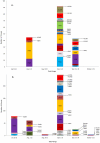Influenza-A viruses in ducks in northwestern Minnesota: fine scale spatial and temporal variation in prevalence and subtype diversity
- PMID: 21931636
- PMCID: PMC3172203
- DOI: 10.1371/journal.pone.0024010
Influenza-A viruses in ducks in northwestern Minnesota: fine scale spatial and temporal variation in prevalence and subtype diversity
Abstract
Waterfowl from northwestern Minnesota were sampled by cloacal swabbing for Avian Influenza Virus (AIV) from July-October in 2007 and 2008. AIV was detected in 222 (9.1%) of 2,441 ducks in 2007 and in 438 (17.9%) of 2,452 ducks in 2008. Prevalence of AIV peaked in late summer. We detected 27 AIV subtypes during 2007 and 31 during 2008. Ten hemagglutinin (HA) subtypes were detected each year (i.e., H1, 3-8, and 10-12 during 2007; H1-8, 10 and 11 during 2008). All neuraminidase (NA) subtypes were detected during each year of the study. Subtype diversity varied between years and increased with prevalence into September. Predominant subtypes during 2007 (comprising ≥5% of subtype diversity) included H1N1, H3N6, H3N8, H4N6, H7N3, H10N7, and H11N9. Predominant subtypes during 2008 included H3N6, H3N8, H4N6, H4N8, H6N1, and H10N7. Additionally, within each HA subtype, the same predominant HA/NA subtype combinations were detected each year and included H1N1, H3N8, H4N6, H5N2, H6N1, H7N3, H8N4, H10N7, and H11N9. The H2N3 and H12N5 viruses also predominated within the H2 and H12 subtypes, respectively, but only were detected during a single year (H2 and H12 viruses were not detected during 2007 and 2008, respectively). Mallards were the predominant species sampled (63.7% of the total), and 531 AIV were isolated from this species (80.5% of the total isolates). Mallard data collected during both years adequately described the observed temporal and spatial prevalence from the total sample and also adequately represented subtype diversity. Juvenile mallards also were adequate in describing the temporal and spatial prevalence of AIV as well as subtype diversity.
Conflict of interest statement
Figures




Similar articles
-
Prevalence of Influenza A Viruses in Ducks Sampled in Northwestern Minnesota and Evidence for Predominance of H3N8 and H4N6 Subtypes in Mallards, 2007-2016.Avian Dis. 2019 Mar 1;63(sp1):126-130. doi: 10.1637/11851-041918-Reg.1. Avian Dis. 2019. PMID: 31131568 Free PMC article.
-
Using RRT-PCR analysis and virus isolation to determine the prevalence of avian influenza virus infections in ducks at Minto Flats State Game Refuge, Alaska, during August 2005.Arch Virol. 2007;152(10):1901-10. doi: 10.1007/s00705-007-0994-1. Epub 2007 Jun 1. Arch Virol. 2007. PMID: 17541700 Free PMC article.
-
Avian influenza viruses in Minnesota ducks during 1998-2000.Avian Dis. 2003;47(3 Suppl):867-71. doi: 10.1637/0005-2086-47.s3.867. Avian Dis. 2003. PMID: 14575079
-
Consecutive natural influenza a virus infections in sentinel mallards in the evident absence of subtype-specific hemagglutination inhibiting antibodies.Transbound Emerg Dis. 2013 Oct;60(5):395-402. doi: 10.1111/j.1865-1682.2012.01357.x. Epub 2012 Jul 22. Transbound Emerg Dis. 2013. PMID: 22816511
-
Avian influenza A viruses in birds --an ecological, ornithological and virological view.Dtsch Tierarztl Wochenschr. 2005 Dec;112(12):448-56. Dtsch Tierarztl Wochenschr. 2005. PMID: 16425630 Review.
Cited by
-
Reassortant influenza A viruses in wild duck populations: effects on viral shedding and persistence in water.Proc Biol Sci. 2012 Oct 7;279(1744):3967-75. doi: 10.1098/rspb.2012.1271. Epub 2012 Aug 1. Proc Biol Sci. 2012. PMID: 22859590 Free PMC article.
-
Characterization of Avian Influenza Virus H10-H12 Subtypes Isolated from Wild Birds in Shanghai, China from 2016 to 2019.Viruses. 2020 Sep 25;12(10):1085. doi: 10.3390/v12101085. Viruses. 2020. PMID: 32992999 Free PMC article.
-
Influenza A virus recovery, diversity, and intercontinental exchange: A multi-year assessment of wild bird sampling at Izembek National Wildlife Refuge, Alaska.PLoS One. 2018 Apr 5;13(4):e0195327. doi: 10.1371/journal.pone.0195327. eCollection 2018. PLoS One. 2018. PMID: 29621333 Free PMC article.
-
Highly Pathogenic H5N1 Influenza A Virus (IAV) in Blue-Winged Teal in the Mississippi Flyway Is Following the Historic Seasonal Pattern of Low-Pathogenicity IAV in Ducks.Pathogens. 2024 Nov 19;13(11):1017. doi: 10.3390/pathogens13111017. Pathogens. 2024. PMID: 39599570 Free PMC article.
-
Influenza A Virus Surveillance in Waterfowl in Missouri, USA, 2005-2013.Avian Dis. 2015 Jun;59(2):303-8. doi: 10.1637/11002-121014-Reg. Avian Dis. 2015. PMID: 26473682 Free PMC article.
References
-
- Hinshaw VS, Webster RG, Turner B. The perpetuation of orthomyxoviruses and paramyxoviruses in Canadian waterfowl. Can J Microbiol. 1980;26:622–629. - PubMed
-
- Stallknecht DE, Shane SM. Host range of avian influenza virus in free-living birds. Vet Res Commun. 1988;12:125–141. - PubMed
-
- Hinshaw VS, Webster RG, Turner B. Water-borne transmission of influenza A viruses. Intervirology. 1979;11:66–69. - PubMed
-
- Olsen B, Munster VJ, Wallensten A, Waldenström J, Osterhaus ADME, et al. Global patterns of influenza A virus in wild birds. Science. 2006;312:384–388. - PubMed
Publication types
MeSH terms
Grants and funding
LinkOut - more resources
Full Text Sources

